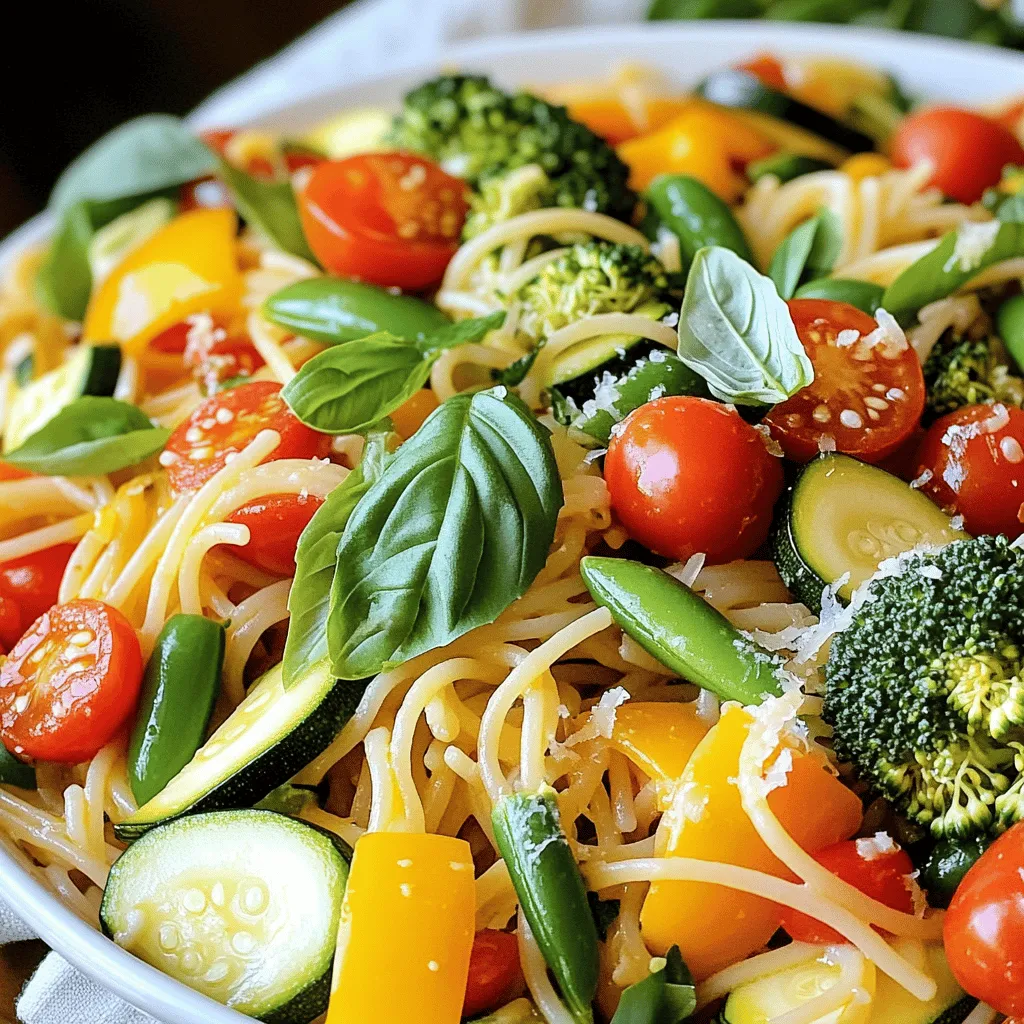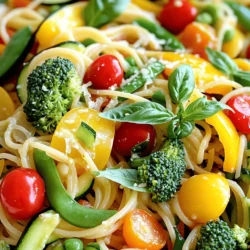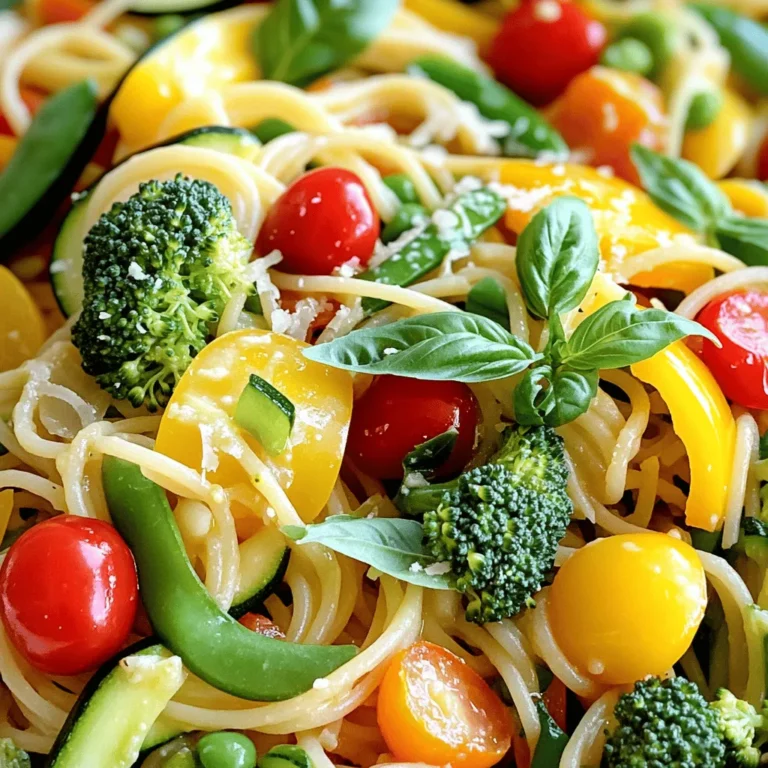Looking for a quick and tasty dinner? You’re in the right place! My Easy Veggie Pasta Primavera is not just simple to make, but it is also packed with fresh, colorful vegetables. This meal comes together in no time, letting you enjoy a vibrant dish that’s perfect for busy nights. Follow me as I break down the steps, tips, and tricks to create this delightful pasta that everyone will love!
Ingredients
Complete List of Ingredients
– Pasta Selection:
– 12 oz spaghetti or your favorite pasta
– Vegetables Variety:
– 1 medium zucchini, sliced
– 1 cup bell peppers (any color), sliced
– 1 cup cherry tomatoes, halved
– 1 cup broccoli florets
– 1 cup snap peas, trimmed
– Seasoning and Garnish:
– 2 tablespoons olive oil
– 3 cloves garlic, minced
– 1 teaspoon dried Italian herbs (basil, oregano)
– Salt and pepper to taste
– ¼ cup grated Parmesan cheese (optional)
– Fresh basil leaves for garnish
Using fresh ingredients is key for great taste. I love to mix colors and textures. The zucchini adds a nice crunch, while the tomatoes provide sweetness. You can choose any bell peppers you like. I often use a mix for a bright look. The broccoli and snap peas add both flavor and nutrition. You can also use leftover veggies if you have them.
For seasoning, olive oil brings richness. Garlic adds depth and aroma. The Italian herbs tie everything together. Adjust salt and pepper to your liking. If you want, sprinkle Parmesan on top for extra flavor. Fresh basil not only looks nice but also adds a burst of freshness.Enjoy your cooking!
Step-by-Step Instructions
Cooking the Pasta
1. Boiling: Start by filling a large pot with water. Add a good amount of salt. Bring it to a boil. Add your pasta and cook it as the package says, usually about 8-10 minutes. You want it to be firm but not hard. This is called al dente.
2. Reserving Pasta Water: Before you drain the pasta, save about one cup of the water. This water has starch and will help bind your dish together later.
Sautéing the Vegetables
1. Prepping the Pan: Grab a large skillet and set it on medium heat. Pour in the olive oil. When the oil is hot, add the minced garlic. Stir it for about one minute. You want it to smell good but not burn.
2. Adding Vegetables: Next, toss in the zucchini, bell peppers, broccoli, and snap peas. Stir them around. Cook for about 5-7 minutes. You want the veggies to be tender but still a little crunchy.
Combining Ingredients
1. Mixing Pasta and Veggies: Now it’s time to add the drained pasta and the reserved pasta water to the skillet. Gently mix everything together. This helps the flavors blend well. Cook for another 2-3 minutes.
2. Seasoning: Sprinkle in the dried Italian herbs, salt, and pepper. Stir again. Taste and adjust the flavors if you think it needs more seasoning.
This Easy Veggie Pasta Primavera is simple yet full of flavor.
Tips & Tricks
Expert Cooking Tips
– Ensuring Al Dente Pasta: To cook pasta just right, boil it in salted water. Check the time on the package. Start tasting a minute early. It should be firm but not hard. Drain and reserve some pasta water. This water helps sauce stick later.
– Enhancing Vegetable Flavor: Heat olive oil in a pan before adding garlic. Sauté garlic for one minute until it smells great. Add veggies in stages. Start with the zucchini and peppers, then add broccoli and snap peas. Cook them for 5 to 7 minutes until they are tender but still crisp.
Customization Ideas
– Substituting Vegetables: You can swap veggies based on what’s fresh or in season. Try asparagus in spring or butternut squash in fall. Spinach or kale also adds great flavor and color.
– Adding Protein: If you want a heartier meal, add protein. Grilled chicken or shrimp works well. Tofu is a great choice for a plant-based option. Just cook it in the pan before adding veggies. For a quick fix, try canned chickpeas.

Variations
Vegan Adaptation
Excluding Cheese: To make this dish vegan, skip the cheese. You can use nutritional yeast for a cheesy taste. It adds a nice flavor without any dairy. You might also try vegan cheese for extra creaminess.
Enhancing Plant-Based Proteins: Add legumes to boost protein. Chickpeas or black beans work well in this recipe. You can also toss in lentils for a hearty texture. These options will fill you up and keep the meal nutritious.
Gluten-Free Option
Suitable Pasta Choices: For a gluten-free meal, use gluten-free pasta. Look for options made from rice, quinoa, or chickpeas. These pasta types cook well and provide great taste.
Adjusting Ingredients: Make sure all your ingredients are gluten-free. Check labels on sauces and spices. This step ensures your whole dish is safe for those avoiding gluten. Enjoy your pasta primavera without worry!
Storage Info
Refrigeration Guidelines
To keep leftovers fresh, store them in an airtight container. Let the pasta cool to room temperature before sealing. This prevents condensation and keeps your dish tasty. You can store it in the fridge for up to three days. After that, the quality may drop, and flavors can fade.
Reheating Techniques
When reheating, you have two great options: the microwave or stovetop. If you choose the microwave, place your pasta in a bowl. Add a splash of water to keep it moist. Heat it in short bursts, stirring often until warm.
For the stovetop, use a skillet over medium heat. Add a little olive oil or water to help it heat evenly. Stir often to avoid burning. This method helps keep the texture nice. Always add moisture when reheating. This prevents the pasta from drying out. Enjoy your Easy Veggie Pasta Primavera just as delicious as before!
FAQs
Common Questions
Can I use frozen vegetables?
Yes, you can use frozen vegetables. They save time and cook fast. Just add them to the skillet with the garlic. Stir and sauté until heated through. This gives you a quick and tasty meal.
How do I make a spicy version?
To add spice, include red pepper flakes. Start with a pinch and adjust to your taste. You can also add chopped fresh chili peppers. Mix them in while cooking the garlic for a kick.
What can I serve with Easy Veggie Pasta Primavera?
This dish pairs well with a simple green salad. Garlic bread makes a great side too. You can also serve it with grilled chicken or shrimp for extra protein.
Troubleshooting
Why is my pasta sticky?
Sticky pasta usually means it overcooked or didn’t have enough water. Make sure to salt the water well. Stir the pasta while it cooks to keep it from sticking together.
How do I know when my vegetables are done?
Your veggies should be tender but still crisp. A fork should easily pierce them. If they lose their color, they may be overcooked. Keep an eye on the cooking time.
Substitutions for missing ingredients: Suggestions and alternatives
If you run out of zucchini, use carrots or squash instead. Bell peppers can swap for any color you like. No cherry tomatoes? Diced regular tomatoes work too. You can mix and match based on what you have. For the cheese, try nutritional yeast for a vegan touch. For a creamy sauce, add a splash of cream or non-dairy milk.
In this post, I’ve shared how to make Easy Veggie Pasta Primavera. We covered the key ingredients, step-by-step cooking instructions, and helpful tips. You learned about delicious vegetable options and how to enhance flavors. This dish is easy to customize for your taste or dietary needs. Finally, I provided storage advice to keep leftovers fresh. Enjoy your cooking and feel free to experiment. Your pasta primavera can always be your own delicious creation!


